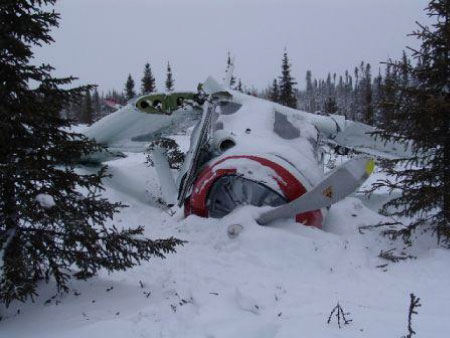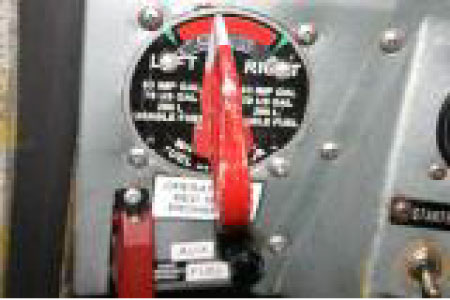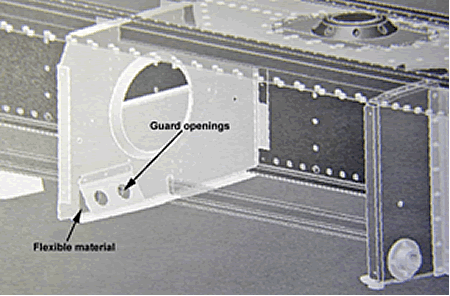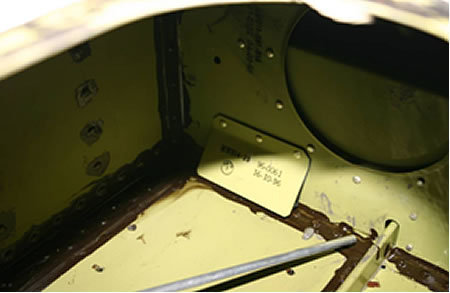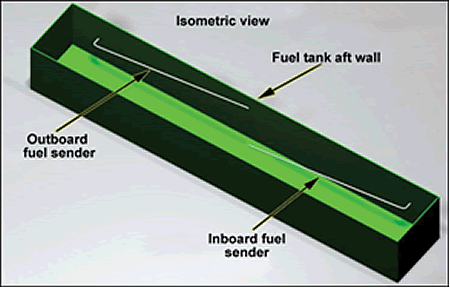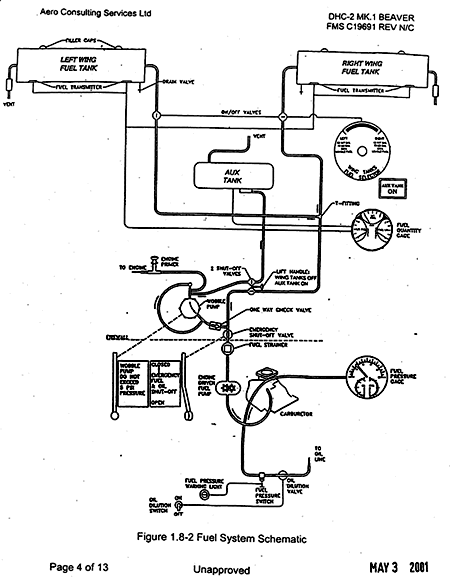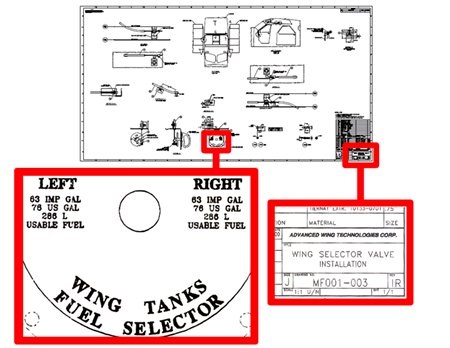Fuel Starvation
DHC-2 Beaver C-GUGQ
La Grande-4, Quebec, 25 nm N
The Transportation Safety Board of Canada (TSB) investigated this occurrence for the purpose of advancing transportation safety. It is not the function of the Board to assign fault or determine civil or criminal liability. This report is not created for use in the context of legal, disciplinary or other proceedings. See Ownership and use of content. Masculine pronouns and position titles may be used to signify all genders to comply with the Canadian Transportation Accident Investigation and Safety Board Act (S.C. 1989, c. 3).
Summary
A ski-equipped DHC-2 MKI Beaver, registration C-GUGQ, serial number 400, took off around 1130 eastern standard time from Mirage Outfitter, located 60 miles east of La Grande-4 Airport, Quebec, with a pilot and four passengers on board, to locate caribou herds. About 40 minutes after departure, the engine stopped as a result of fuel starvation. The pilot was not able to regain power and made a forced landing on rugged ground. The aircraft was heavily damaged and two passengers were seriously injured. The pilot used a satellite telephone to request assistance. First-aid assistance arrived by helicopter about 1 hour 30 minutes after the occurrence. The aircraft fuel system had been modified after the installation of wings made by Advanced Wing Technologies Corporation.
Factual information
Propair Inc. holds a valid Transport Canada operations certificate and operated the DHC-2 from Mirage Outfitter to carry hunters. The purpose of the flight was to locate herds of caribou and should have lasted about 30 minutes. The weather conditions were good for visual flight and the outside temperature was −22°C. Before the flight, the pilot filled the belly fuel tank (auxiliary tank), which has a fuel capacity of 29 gallons.Footnote 1 Using a hand-made wooden gauge, he measured the fuel level in the wing tanks and estimated that each wing tank contained 20 gallons. According to the total estimated quantity of fuel (69 gallons), the aircraft had an endurance of about three hours.
The pilot used a Garmin 296 global positioning system (GPS) as a navigational aid. According to the data retrieved from the GPS, the aircraft took off from Mirage Outfitter at approximately 1130 eastern standard timeFootnote 2 and headed northwest of the La Grande-4 reservoir at an average altitude of approximately 1850Footnote 3 feet above sea level (asl). At about 1206, when the aircraft was at 1800 feet asl or 560 feet above the ground, the low fuel pressure warning light illuminated, but the pilot initially thought that it was the sun's reflection. A few seconds later, the engine sputtered. The pilot noticed that the fuel pressure was at zero.
He selected the belly fuel tank (auxiliary tank), brought the throttle to one-third and activated the wobble pump. The engine, which kept windmilling, spluttered a few times but did not regain power. The pilot tried unsuccessfully to glide to a lake. He did not have the time to lower the flaps completely, and they remained at 10°. The aircraft landed on sparsely wooded but rough ground. At first contact, the skis and main landing gear were torn off. The aircraft slid on its belly for about 100 feet before coming to rest. The right wing broke and the aircraft tilted to the left. The cabin was not seriously deformed but the anchors of two seats in the second row were torn off, as well as the safety belt fastener on a third seat. The passenger seated behind the pilot suffered serious back injuries and the passenger in the front seat suffered head injuries that resulted in the loss of an eye.
The pilot used a satellite telephone to request help. A helicopter working for Hydro-Québec first evacuated three passengers, including the two seriously injured, approximately 1 hour 30 minutes after the occurrence. One of the occupants of the helicopter stayed at the site with the occurrence pilot and the other passenger until the helicopter returned about 40 minutes later.
After the accident, the wing tips were touching the ground; as a result, the remaining fuel ran to the outboard partFootnote 4 of the tanks. These fuel tanks contained less fuel than the unusable fuel quantity. Because the fuel filter broke in the accident, the contents of the belly fuel tank (auxiliary tank) drained out onto the ground.
The information gathered indicated that, at departure, the triple fuel level gauge showed that the left tank was a little more than half full and the right tank was a little less than half full. The centre gauge (auxiliary tank) was showing full. Just before the engine stopped, one of the passengers noticed that the right gauge (right fuel tank) was showing empty while the two other gauges (auxiliary and left fuel tanks) had not moved.
The pilot was certified and qualified for the flight in accordance with existing regulations. He held a commercial pilot licence (aeroplane) since March 2002 and was qualified for instrument flight in April 2006. He had accumulated 1200 flying hours on the Beaver, including 400 hours on the occurrence aircraft.
Aircraft Modifications
A review of the documentation indicated that the aircraft was maintained in accordance with regulations. The aircraft had undergone several modifications since it had been put into service in 1950, including the installation of wings made by Advanced Wing Technologies Corporation (AWT) according to Supplementary Type Certificate (STC)Footnote 5 SA97-88 issue 6. AWT retained the assistance of Aero Consulting Services (ACS) to document and prepare all the required data to be presented to Transport Canada for certification. With the new wings, the aircraft's span went from 48 feet to 52 feet 2 inches. A 66-gallon integral fuel tankFootnote 6 was installed in each wing. These fuel tanks were about 10 inches wide and high, and about 10 feet long. They consisted of seven compartments separated by bulkheads with holes to prevent excessive fuel sloshing.
The Beaver's original fuel system consisted of three separate fuel tanks located under the cabin floor. A pump driven by the engine drew in the fuel and a selector was used to select the tank. A wobble pump whose handle was on the centre console made it possible to feed the engine with fuel in case the engine pump failed. The new system only retained the front belly tank, which can hold 29 gallons, and became an auxiliary tank. The system is equipped with two fuel tank selectors. The original fuel tank selector on the left of the instrument panel was modified to operate the valves at the root of each wing. A teleflex cable transmits the command from the selector to the left valve. From there, the movement is transmitted to the right valve via a secondary smaller cable. This cable runs over the roof of the central cabin between the aircraft skin and the interior finish. Turning the selector opens one of the valves and closes the other. A red range on the wing tank selector placard, between the left and right position, prohibits placing the selector in that mid position. Photo 2 shows the position of the selector and the placard as found installed in the aircraft. The location and appearance does not conform to drawing MF001-003 and incorrectly displays 79 US GAL as usable fuel whereas it should read 76 US GAL (see Appendix B). The second selector, called the AUXILIARY FUEL CONTROL, was located on the floor, to the left and in front of the pilot's seat. It was used to select either the wing tanks or the belly tank (auxiliary tank). An AUX TANK ON light confirmed the selection. The flight manual supplement for the AWT modification indicates that only one of the three fuel tanks can be selected at a time.
During winter operation, being able to select one wing tank or the other was not assured because the secondary cable would freeze. Because of this problem, the company pilots had adopted the practice of placing the wing tank selector in the middle position, as was the case during the occurrence flight. This position partially opened both valves and had shown over the course of several hundred hours of operation that it could provide an adequate flow of fuel to the engine. As this procedure did not conform to the flight manual supplement, the operator should have objected and ensured that the pilots operated the aircraft in accordance with the amended flight manual.
Pilots reported that, because of the longer wings on the aircraft, it was more demanding to maintain coordinated flight than a standard DHC-2. In this case, the partial opening of both valves allowed the fuel to flow toward the low wing. Because of the length of the tanks, the fuel could run to the outboard of one of the tanks, leaving the fuel supply outlet uncovered, especially when the fuel level was low.
The flow of fuel between the wings should have stopped in the first compartment of each tank where the fuel supply outlet was located (see Appendix A). These compartments are equipped with a flapper valve to stop the fuel from returning to the outboard compartments. The flapper was made of a flexible material similar to neoprene. It was riveted to the outboard bulkhead, behind a guard (part number MW14-99) that restricted its movement and kept it in proper position. The investigation revealed that the guards were not fabricated in accordance with the drawings (see Figure 1); two round openings about one inch in diameter were not drilled (see Photo 3). Normally, the openings allowed the fuel to put pressure on the flapper and help keep it closed. Without the openings, the fuel could flow around the guard and lift the side of the flapper. Also, the bulkhead is installed at a right angle to the wing. Considering the 2° dihedral angle and that the flapper is only maintained against the bulkhead by gravity, proper sealing was not assured. As a result, fuel could return toward the outboard compartments.
All aircraft modifications were completed in June 2002. Six months later, AWT declared bankruptcy. Because of the legal procedures, Avionnerie Val-d'Or did not become the owner of the type design until November 2006. In order to take action affecting the type design, the new owner must satisfy specific Canadian Aviation Regulations (CARs) requirements before being qualified as holder of the STC. At the time of the accident, the procedure to become compliant had not been initiated; however, this process is underway.
The low fuel pressure warning light illuminates when the pressure is below 2 or 3 psi (pounds per square inch). When the pressure drops to zero, fuel is no longer transferred to the carburetor. At that point, the fuel in the carburetor bowl will continue to feed the engine for a few seconds depending on the power used. Tests carried out following the modification showed that the fuel continued to feed for 13 seconds at an engine revolution of 1800 rpm and a manifold pressure of 28 inches of mercury. Since the modifications, the aircraft had experienced engine power losses on several occasions; all incidents occurred during the summer. In some cases, the engine power loss was caused by a delay in changing the wing tank selector after a tank was emptied. In other cases, there was sufficient fuel in the wing tanks, and the cause of the engine power loss could not be determined. Each time, the engine regained power a few seconds after the auxiliary tank was selected.
The fuel pressure gauge and the low fuel pressure switch were examined at the TSB Engineering Laboratory. The fuel pressure gauge pointer was trapped at the 3.3 psi indication due to accident damage. Tests on the low fuel pressure switch showed that it was calibrated to activate the low fuel pressure warning light at 2.82 psi and deactivated at 2.83 psi. However, testing also showed that the switch operated intermittently below 3.0 psi.
The modification to the fuel system included replacing the original fuel level gauge with a Westach triple fuel level gauge. The gauges were identified as FUEL LEFT, AUX FUEL and FUEL RIGHT. The three fuel tanks were equipped with Westach fuel senders (model 395-5S-1B-5-24). Two fuel senders were installed at mid-height on the aft wall of each wing tank (see Figure 2). The outboard fuel sender transmitted the fuel level for the top half of the tank, while the inboard fuel sender was for the bottom half. AWT drawing MF001-005 rev IR specified that the fuel senders had to be bent into an inverted U-shape. However, as per Westach, the model number specified at the AWT drawing cannot be bent into an inverted U-shape. It can only be bent near its anchorage at an angle up to 90°. Consequently, the shape of the fuel senders was in accordance with Westach instructions but the AWT drawing was not. The drawing also wrongly quoted part number WS34T13 for the triple fuel indicator. That part number is not known to Westach. The only indicator recommended for use with their fuel sender is indicator part number A3T13-IV, which was found installed in the aircraft.
The probe of the outboard fuel sender in the left tank had rotated in its base to an almost horizontal position until its tip contacted a bulkhead. Several friction marks on the bulkhead indicated that the probe had moved before the accident. Since the fuel sender was immersed until the tank level reached about half, the signal transmitted to the fuel level gauge was for a full tank.
Canadian regulations require that aeronautical products be certified according to the standards in force.Footnote 8 The models of fuel sender and fuel level gauge used had not been submitted to the certification standards by Westach. Consequently, the required testsFootnote 9 should have been conducted by AWT. Since no documentation showing their certification was submitted during the investigation, the certification of these components could not be confirmed.
Contrary to the instructions from Westach, which state that only one sender should be connected to the fuel level gauge, the STC specifies that the electrical wiring for the two fuel senders for each tank must be wired in parallel and connected to the fuel level gauge.
The certification project (Fuel System Functional Test Plan and Report)Footnote 10 submitted to Transport Canada had been amended by an addendum.Footnote 11 The existing fuel system complied partly with the addendum. However, this document referred to float gauges wired in series, while the drawings showed fuel senders wired in parallel. In addition, contrary to the calibration report,Footnote 12 a totalizing system to accommodate the two fuel senders per tank did not appear on the drawing. According to Westach, using a totalizing system required a fuel level gauge capable of reading higher voltages than those of the triple fuel level gauge used. The Fuel System Functional Test Plan and Report stated that the tests demonstrated that the system correctly showed the ¼, ½ and ¾ levels. However, the report did not provide any correlation between these indications and the corresponding amount of fuel in gallons.
The fuel senders installed on the aircraft were designed to operate at input voltages ranging from 9 to 28 volts direct current (DC). The output voltage ranges from 0 to 5 volts depending on the depth the probe is submerged into the fuel. The indication was linear in the sense that 2.5 volts indicated half full. During testing, the inboard fuel sender in the left tank produced an output of only 1.69 volts when it was completely immersed. The two fuel senders were wired in parallel according to the STC drawings,Footnote 13 and immersed in the fuel before being removed gradually to simulate fuel consumption. When simulating a full tank, the maximum output voltage obtained was 3.9 volts, which gave a ¾ reading on the fuel level gauge. When simulating half a tank, the indication was 5/8. None of the readings were linear and the only correct indication obtained was the simulation of an empty tank. It was also observed that, when the tip of the probe was in contact with water or ice, the indication varied only slightly and remained around ¾ regardless of the level in the tank.
Pilots who flew this aircraft reported that the fuel level gauges for the wing tanks were not reliable. The operator was not able to correct the problem. When an abnormal condition cannot be corrected while following an approved maintenance procedure, a service difficulty report (SDR) must be submitted to Transport Canada and the manufacturer informed of the problem. If an STC recognized by Transport Canada becomes orphan, Transport Canada becomes responsible for any safety issue brought to its attention. Because of AWT's bankruptcy and the legal complications, the operator did not attempt to revise the operating procedures or to report the fuel senders calibration problems.
The procedure for restarting the engine described in the aircraft flight manual supplement, prepared after the wings replacement, was identical to the original flight manual, except for the need to select the auxiliary tank. Among other things, the pilot had to bring the throttle to one third, increase the propeller pitch to high, activate the priming pump and use the wobble pump if there was no fuel pressure. The pilot kept the propeller at cruise pitch and was not able to activate the priming pump, located on the floor to his left. The flight manual supplement stated that, if the engine does not restart, the flaps should be set to the cruise flaps position. This position applied to the original wings, but does not exist for the new wings.
The pilot and co-pilot seats were equipped with shoulder harnesses with inertia reels. Those harnesses were not used during the occurrence flight, contrary to Section 703.69 of the CARs.Footnote 14 The information gathered indicated that the inertia reel sometimes locked and could prevent the pilot from reaching the wing flap lever. The inertia system in the reel is designed to lock the reel when subjected to abrupt deceleration or rapid unrolling. Inspection of the aircraft revealed that the shoulder harnesses were stored underneath the aircraft interior covering and were neither visible to the passenger nor was he briefed on its availability. No deficiencies were documented on the operation of the inertia reels and none were detected during the examination.
The safety belts were bolted to their respective seats. On impact, the rear left leg floor attachment for the seat behind the pilot broke and the anchor for the rear right leg of the seat behind the co-pilot was torn off the floor. The occupants of these seats were thrown into the backs of the pilot and co-pilot seats, and the backs of these seats broke. The back seat remained anchored to the floor, but the safety belt floor attachments failed. An analysisFootnote 15 done in the past by the TSB on the same type of seat attachment had concluded that the failures had been caused by loads exceeding the design limit.
Analysis
ince the wing tank fuel level gauges were not very reliable, the pilot used a calibrated wooden stick to determine the amount of fuel in the wing tanks. This method, although recognized, is not always very accurate. If the stick is moved, the fuel can wet more of the stick and give a reading that is higher than the real level. Given the length of the tanks, a small error in the reading could correspond to a difference of several gallons. Considering that the aircraft had flown for only 40 minutes before the engine stopped, it can be concluded that the aircraft took off with less fuel in the wing tanks than the amount estimated by the pilot.
The engine stopped as a result of fuel starvation while part of the pilot's attention was focused on looking for caribou tracks. When the low fuel pressure warning light illuminated, the pilot first thought that it was the sun's reflection and did not select another fuel tank before the engine power loss. Given the random operation of the low fuel pressure switch, it is also plausible that the warning light did not indicate the drop in fuel pressure in a timely manner. Since the engine continued to operate, the fact that the propeller pitch was not changed did not have an impact on the restarting of the engine.
It is probable that using the priming pump, especially in cold weather, would have helped the engine to restart. However, the low altitude reduced the time available to carry out the emergency procedure. With the wobble pump lever located on the centre console, the flap lever located on the floor to the right of the pilot's seat and the priming pump located on the floor to the pilot's left, it was difficult for the pilot to activate all these devices at the same time and also keep one hand on the controls.
The failure of the legs of the second row seats caused the occupants to be thrown against the backs of the front seats. Since the pilot and the front passenger were not wearing their shoulder harnesses, the risk of sustaining greater injuries was increased. In fact, the front passenger sustained head injuries that resulted in the loss of an eye.
After AWT's bankruptcy, Propair could no longer rely on the STC holder for any technical support to find a solution to the problems related to the fuel level indication and the selection of the wing tanks in cold weather. Even though choosing the middle position of the selector cancelled the risk of blocked actuating cables in cold weather, this selection was not authorized by the flight manual supplement, and the operator should have reported the problem and researched an alternative. The middle position allowed fuel to flow between the wing tanks. Normally, the non-return valves should have kept the fuel in the first compartment. However, the non-compliant guard and the angle at which the flapper valves were mounted compromised their effectiveness. It is possible that earlier engine power losses were caused by a lack of fuel to the engine after non-coordinated flight, which could have allowed fuel to end up in the outboard compartment of one of the tanks.
Tests on the components of the fuel level indication system established that the only time the fuel level in the wing tank was shown correctly was when the tank was empty. However, any water or ice on one of the two fuel senders could incorrectly maintain the indication at approximately ¾.
With the wing tank selector in the middle position, the engine was fed fuel from both wing tanks at the same time. As a result, the fuel level in each tank should have decreased equally. The left tank gauge pointer did not move during the flight and stayed at more than ½. It is likely that the reading for the left tank was distorted by the presence of ice in the fuel. The indication error did not allow the pilot to select another fuel tank before using all the fuel in the wing tanks.
No documentation was provided confirming that a certification process for the fuel senders or the triple fuel level gauge had been carried out. When the change to the type design was approved through issuance of the STC, Transport Canada did not notice the fact that these parts, described in the plans, did not comply with airworthiness standards. Similarly, the following deficiencies were not noticed:
- the bending of the fuel senders;
- the absence of perforations in the flapper valve guards;
- the wing fuel selector placard did not conform to drawing MF001-003 (Rev IR); and
- the description of the fuel system.
Consequently, Transport Canada issued an STC that contained several deficiencies.
The following Engineering Laboratory reports were completed:
- LP 016/2007 – Examination of Instruments
- LP 073/2007 – GPS Analysis
These reports are available from the Transportation Safety Board of Canada upon request.
Findings
Findings as to causes and contributing factors
- The engine stopped as a result of fuel starvation; the amount of fuel in the wings was less than the amount estimated by the pilot, the fuel senders gave an incorrect reading, and the low fuel pressure warning light could illuminate randomly.
- The engine stopped at low altitude, which reduced the time needed to complete the emergency procedure. The pilot was unable to glide to the lake and made a forced landing on an unsuitable terrain, causing significant damage to the aircraft and injuries to the occupants.
Findings as to risk
- The wing tank selection system was subject to icing in cold weather, and the pilots adopted the practice to place the wing tank selector in the middle position, which is contrary to the aircraft flight manual supplement instructions and a placard posted on the instrument panel.
- When the change to the type design was approved through issuance of the Supplementary Type Certificate (STC), Transport Canada did not notice the fact that the fuel senders and triple fuel level gauge did not meet airworthiness standards; Transport Canada issued an STC that contained several deficiencies.
- Storage of the shoulder harnesses underneath the aircraft interior covering made them inaccessible; since the pilot and the front seat passenger did not wear their shoulder harness, their protection was reduced.
This report concludes the Transportation Safety Board's investigation into this occurrence. Consequently, the Board authorized the release of this report on .
